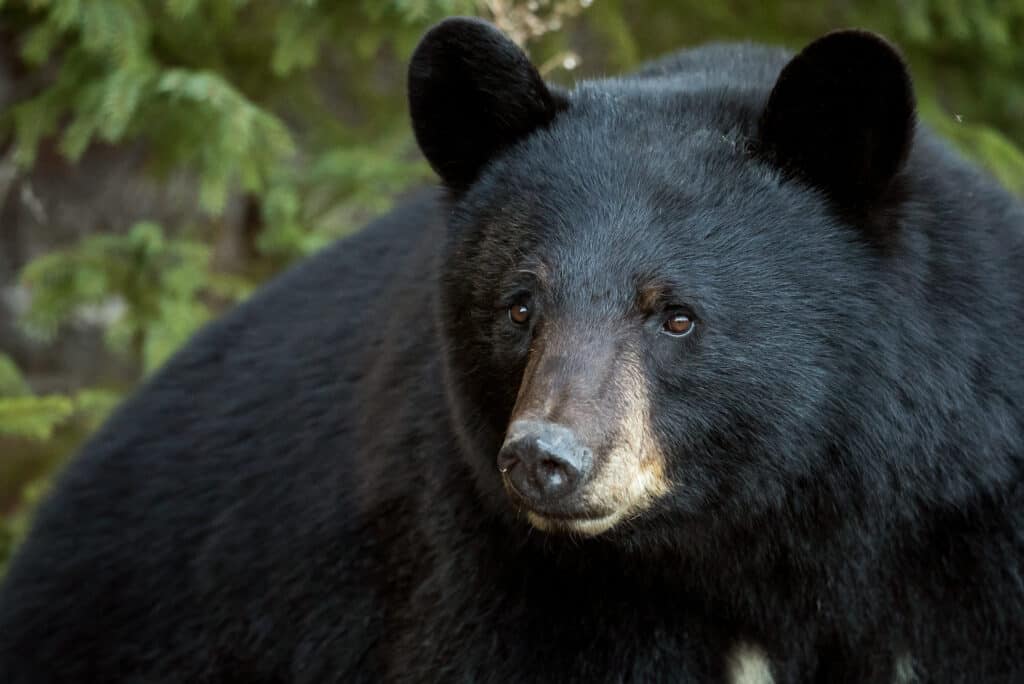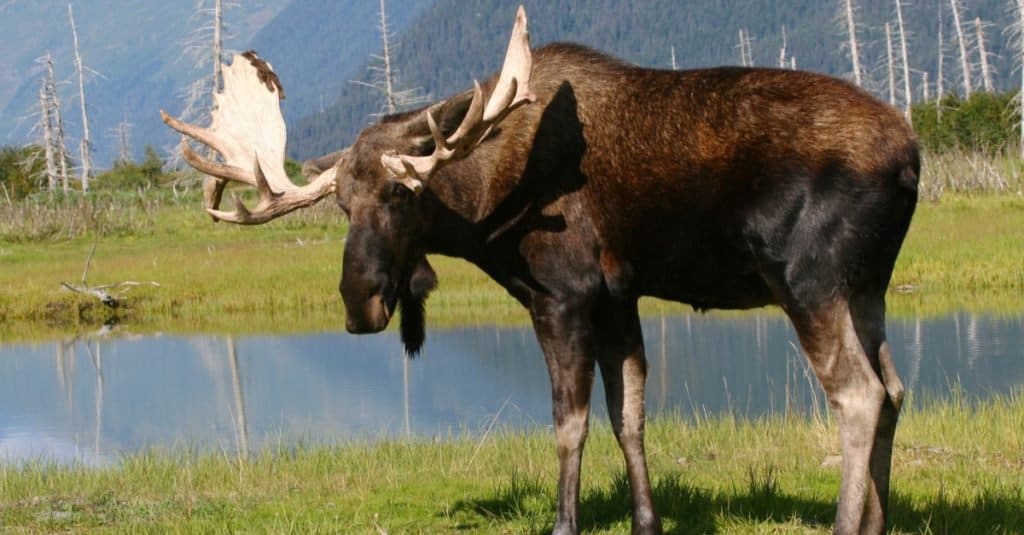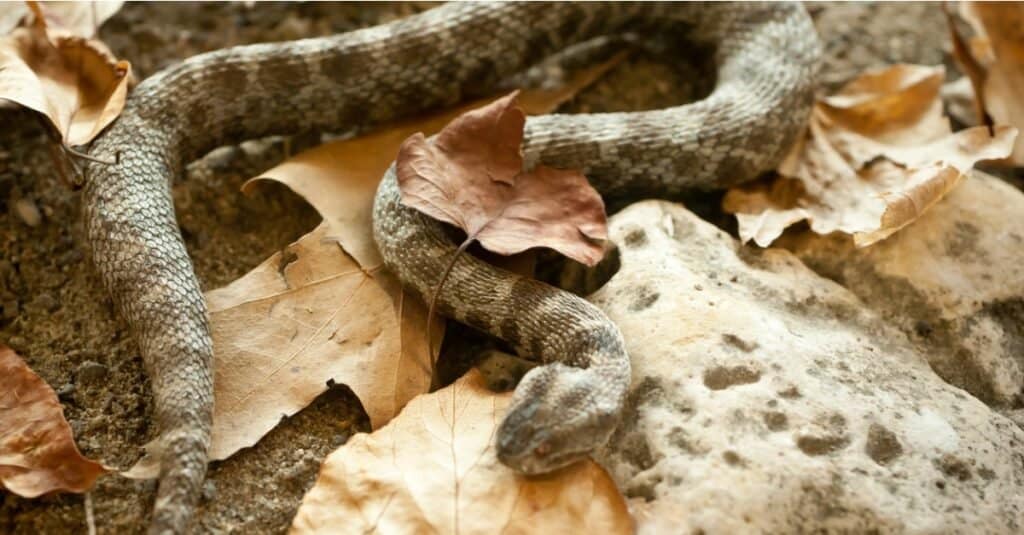There are plenty of dangerous adventure sports in Colorado like white water rafting, ice climbing, hang gliding and Heli-skiing! In March of 2021 there was a deadly heli-skiing accident where the helicopter crashed killing five and seriously injuring another. This accident was in Alaska, but back in 1993 an accident just outside of Aspen, CO, killed three when the helicopter had a mechanical failure. Participating in such sports has its known risks, but what about camping, hiking or just walking your dog? These should be safe activities unless you run into one of the dangerous animals on our list! Let’s look at some of the deadliest animals in Colorado!
Are Black Bears the Deadliest Animals in Colorado?
Black bears are smaller than grizzly bears but can still grow to be 200-600 pound and have claws that are 1.57 inches long. They also have a mouth full of sharp teeth including canines that are much larger than the rest of their teeth. According to Colorado Park and Wildlife there are between 17,000-20,000 black bears living in Colorado. With numbers that high you would think there would be significant bear-human conflicts but in reality, there have only been four fatalities since 1971 including a recent death of a 39-year-old woman who was attacked near Durango, CO, in the spring of 2021. She was out walking her dogs when she was attacked. Three bears were later found nearby, a mom and two cubs and were euthanized as they were considered a threat. If you are in bear country you can arm yourself with bear spray which can be used like mace to deter a bear attack, but remember it is still extremely rare to be attacked by a bear.

A black bear’s claws are over an inch and a half long.
©iStock.com/Brittany Crossman
Are Moose the Deadliest Animals in Colorado?
Moose are big! You may think they are the size of deer with a large rack, but they can grow to be 6 feet tall at the shoulder. Their rack can grow to be 4-feet wide. They typically stay away from humans but in August of 2021 there were four separate moose attacks, none of which were provoked. Here are examples of moose attacks in Colorado:
- August 7, Clear Creek County, man walking towards a lake saw a moose. When it suddenly charged him, he was able to duck behind a tree to avoid injury. (The incident was caught on video).
- August 13, Glenwood Springs, a 79-year-old woman was walking a friend’s dog. She said she had seen a mother moose and two calves earlier but waited until they were gone before taking the dog out. Despite waiting, the moose was nearby and confronted her and then attacked. She suffered severe injuries and had to be helicoptered to a nearby hospital.
- August 26, Winter Park, a 62-year-old man was attacked by a male moose while he was out running with his dogs. He suffered minor injuries.
- August 29, Winter Park, a woman was injured by a moose when she was out walking in the dark between 4:30 and 5:30 a.m. A Colorado Parks and Wildlife Manager recommended that people should carry a light with them or walk in well-lit areas if they are in an area known to be inhabited by moose.

Moose are huge animals reaching six feet tall at the shoulder.
©Steve Bower/Shutterstock.com
Mountain Lions vs. Mountain Goats, Which Is More Deadly?
If you were a Roman gladiator and were chosen to fight a wild beast like a lion, crocodile or bear what kind of animal do you think you would choose? Although animal fights in the Colosseum get a lot of press, according to the History Channel, fights involving animals were pretty rare; it was the standard that gladiators fought other gladiators. But if your gladiator run included an animal day and you had to choose between a mountain lion or a mountain goat, which would you choose? Goats seem a lot less fierce to me, but let’s find out about the real dangers of mountain lions and mountain goats.
- Mountain lions: The mountain lion population in Colorado is around 3,800-4,400 and they live throughout the state. Mountain lions have sharp teeth and claws and are fast…really fast! You would not be able to outrun a mountain lion, which can reach top speeds of 50 mph! In Colorado there have been 25 incidents where mountain lions have attacked people in the past 30 years, with three of those resulting in fatalities. One of the most recent attacks happened in 2020 and involved a sheriff’s deputy from Larimer County that was responding to a call involving a mountain lion attack. A group of deputies surrounded the mountain lion and it attacked one of them. She fell to the ground and fought off the lion while another deputy helped get it off of her. A bystander captured the incident on video. The lion ran off and the deputies later found it and put it down to keep others safe. Both the deputy and the original victim of the attack were treated for injuries and released.
- Mountain goats: Watching the video of the mountain lion attack I can’t imagine a mountain goat would be scarier, but I may have forgotten about their long, spear-like horns. These goats are mostly white. They can reach 100-300 pounds and can be three feet tall at the shoulder, so they are much bigger than you may have thought. Both the males and females have horns that can grow to be up to 10 inches long! That is their biggest threat. Park rangers are concerned about the increase in human interactions with mountain goats because they know how unpredictable they can be. They try to educate visitors to stay away from the goats, not to approach them, and certainly do not offer them food. Fatal attacks are extremely rare but there was a hiker back in 2010 that was attacked and killed in Olympic National Park in Washington.

Mountain lions can reach speeds up to 50 mph.
©iStock.com/SandmanXX
Smaller Size but Bigger Threat: Snakes, Spiders and Ticks
The animals responsible for the most deaths in Colorado are actually smaller animals like snakes, spiders and ticks. Colorado has several species of venomous rattlesnakes, at least two kinds of venomous spiders and a wood tick that carries infectious diseases. The three venomous snakes in Colorado are:

Western massasauga rattlesnakes are small snakes with heart-shaped heads, and vertical pupils and thick bodies.
©iStock.com/Westhoff
The two venomous spiders in Colorado are:
- Black widow
- Brown recluse
The most dangerous tick in Colorado:
- Rocky mountain wood tick
According to the Centers for Disease Control and Prevention (CDC), thousands of people are bitten by snakes each year in the U.S. but there are on average only five deaths that result from snake bites. For spiders the statistic is also very low with only seven spider-related deaths per year. For tick-borne diseases, the most concerning is Rocky Mountain Spotted Fever which is also called Spotted Fever Rickettsiosis (SFR). The CDC’s records indicate that in 2019 there were between 5,000-5,500 cases reported with a fatality rate of 5-10%, so this is a serious threat. To avoid wood ticks, it is recommended to wear tick repellent and long sleeves and tuck your pants into your socks. Also, if you have been in an area with ticks be sure to check your body and clothes for ticks to avoid a bite later. Following these guidelines will help diminish the chances of being bitten and allow you to enjoy the beautiful outdoors.
Up Next
- Native Wildlife in Colorado: A Complete Guide
- Discover The 8 Largest Animals In Colorado, and Where You’ll Find Them
- The 3 Biggest Spiders in Colorado
The photo featured at the top of this post is © Scott E Read/Shutterstock.com
Thank you for reading! Have some feedback for us? Contact the AZ Animals editorial team.






